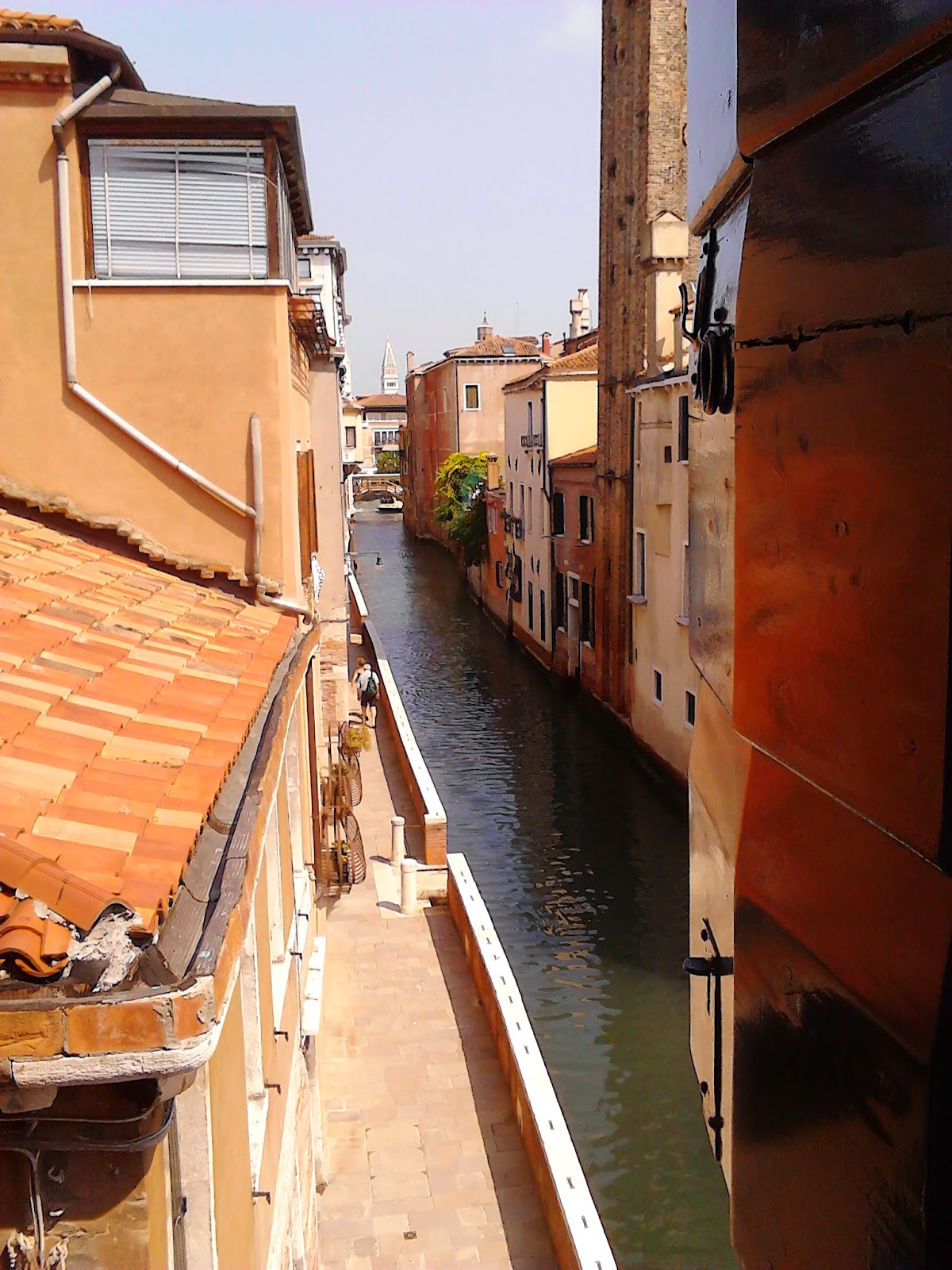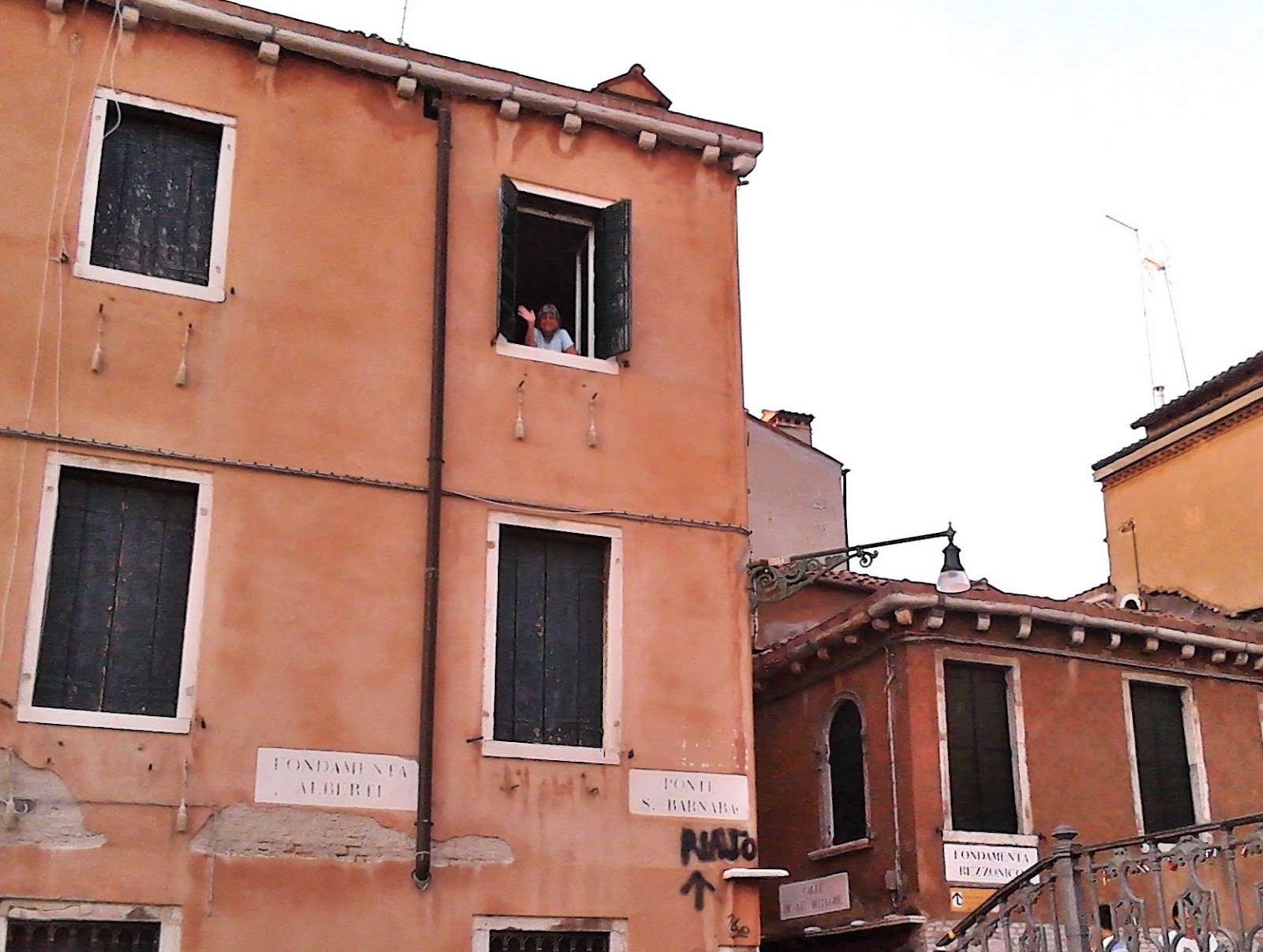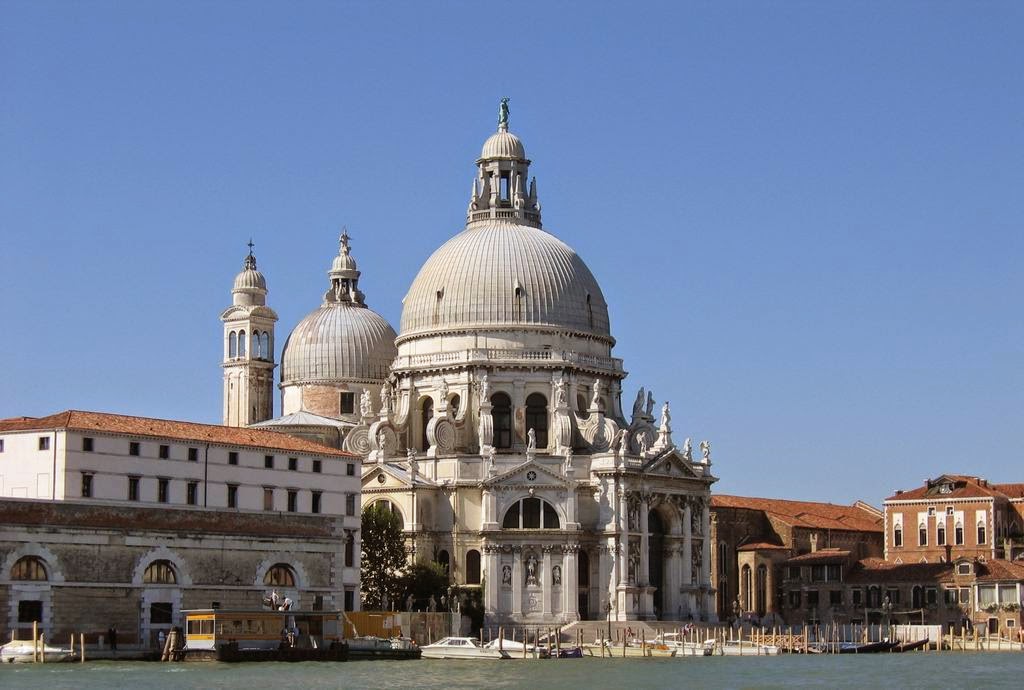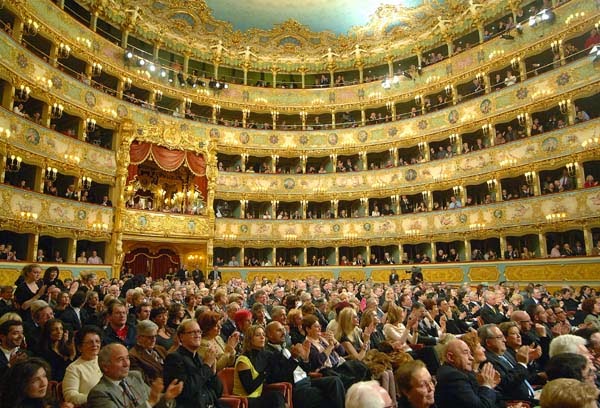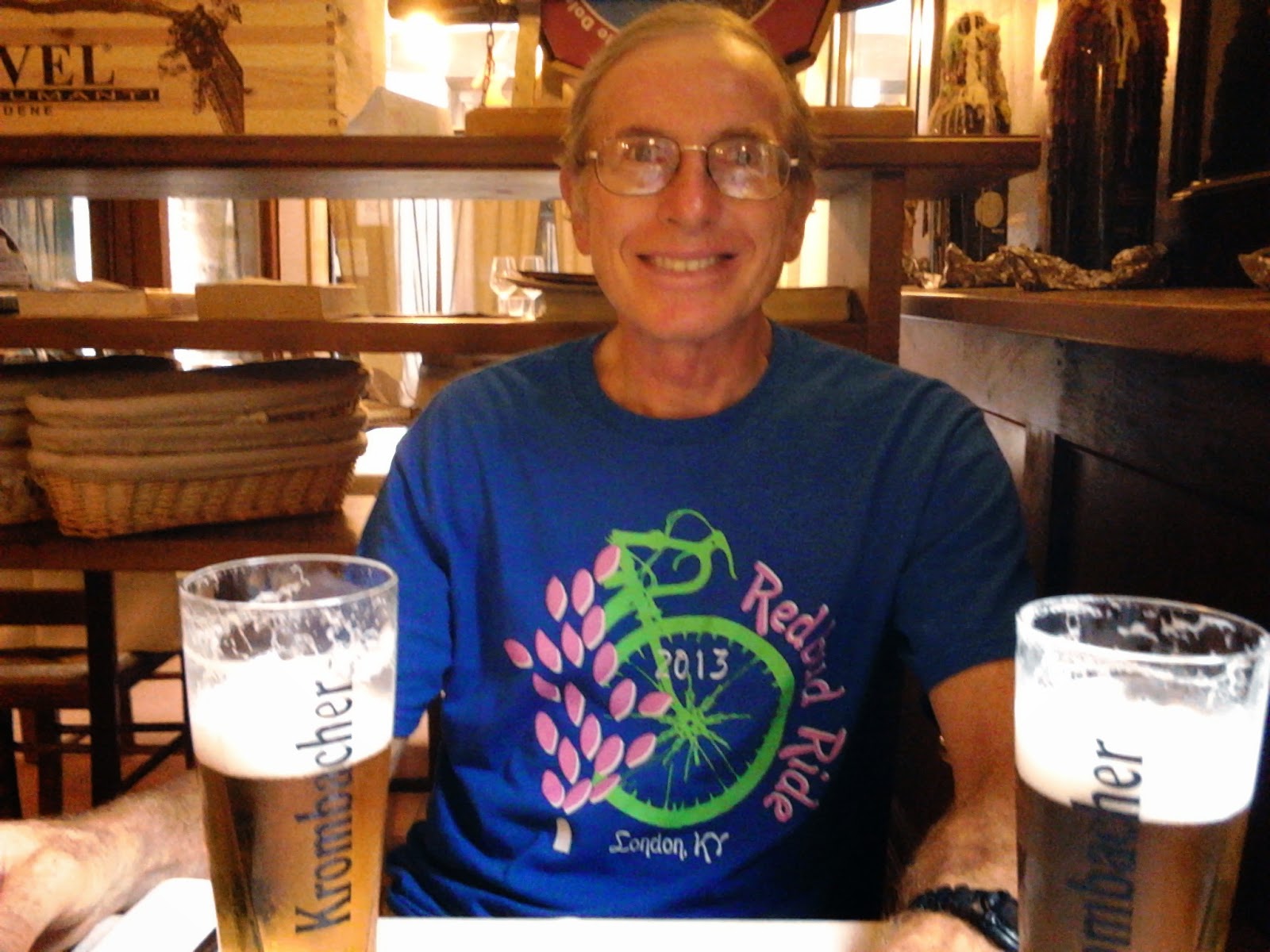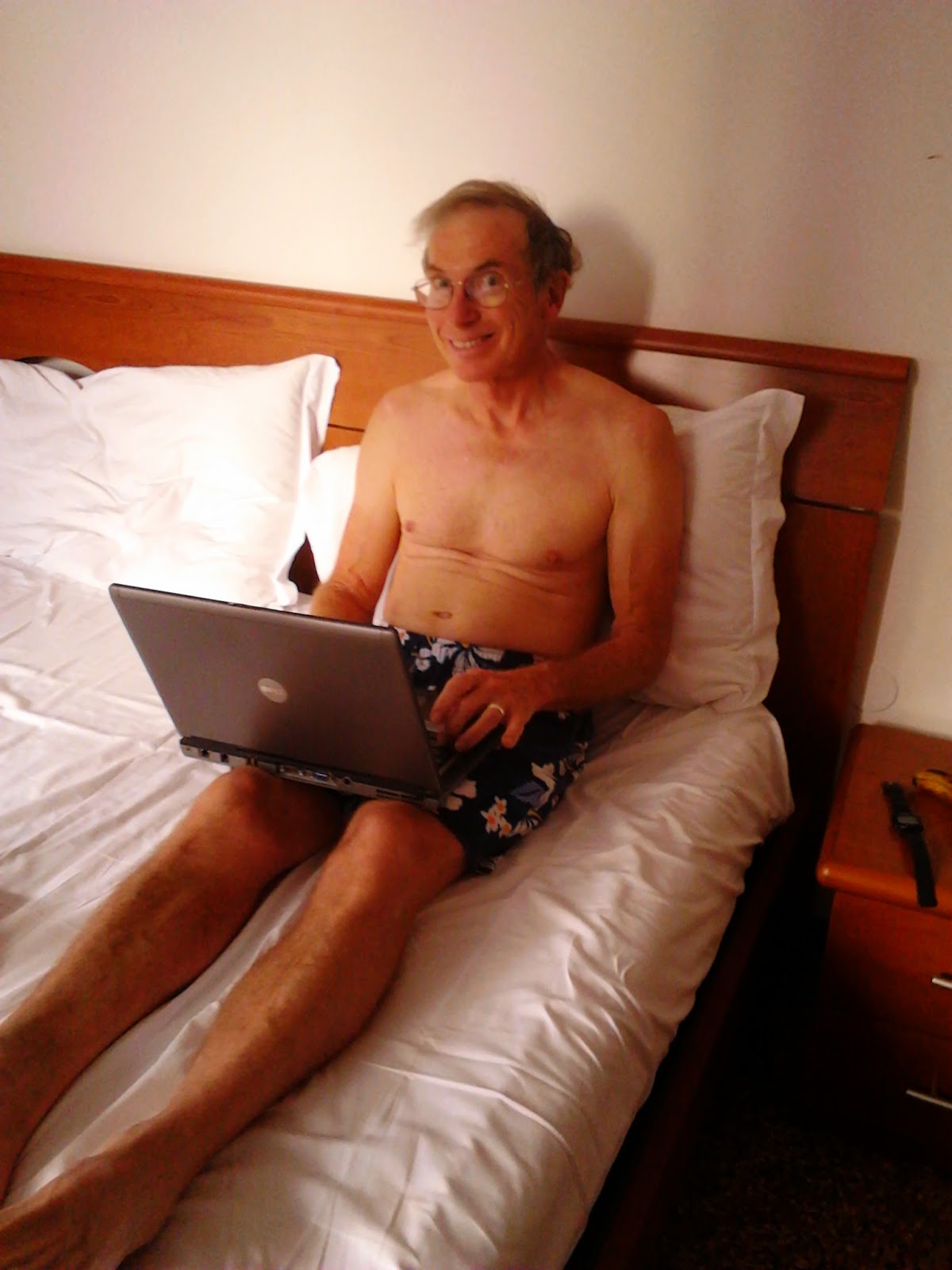Day 18 Flight home from Venice Monday, August 11, 2014
This is my souvenir from our final morning in Venice. I lowered the window in our vaporetto as we were cruising down the canals on our way to the airport, and it fell onto my thumb. This photo was taken six weeks later, and it looks like this Venice souvenir will be lasting quite a while longer.
Everything went fine on our final morning. We figured out how to work the BnB coffee maker, and ate some snacks that we found in the kitchen. We got our suitcases all closed up and headed on out to the Grand Canal for the final time. We got to the dock so early that we caught an earlier airport vaporetto than the one we had planned on. It was a picturesque final cruise through Venice, out into the lagoon, and across it to the airport. When we embarked the vaporetto, we were only the second people to get on; but by the time we headed across the lagoon, we had stopped several more times and the boat was fully crowded.
Our walk from the airport dock to the terminal was actually quite far. Even at 9:30 am, it was already hot and humid enough for us to be working up a sweat pulling our luggage that far. Everything went like clockwork in the terminal, and soon we were seated at our departure gate. Lo and behold, there were Angela, Chris, and Hannah with whom we had toured Florence, Pisa, and Rome.
The flight to Philadelphia was just fine and dandy. We watched movies. Our layover time was long, about three hours, plus there were some delays leaving. But we made it to Dayton, and Brandon picked us up and drove us to his condo where we got Janet's car and drove home. It was over. What a trip!
Mediterranean Cruise
9/25/2014
9/21/2014
Full day in Venice
Day 17 Venice, Italy Sunday, August 10, 2014
We walked, vaporettoed, and gondola-ed all over beautiful Venice today. This photo is at the Accademia Bridge, which took us back over to the San Marco side of the city, where we toured the majestic basilica.
Our landlord had e-mailed that we could not drop off our luggage early, even
though he originally had said we could. Luckily, a local woman on the vaporetto
let me use her cell phone to call him since my attempts to use the public pay
phone did not work. After much angst and yelling, he seemed to understand that
I wanted only to leave our luggage and would wait to check in at the appointed time in
the afternoon.
When we got to the BnB and rang the doorbell, one of the tenants answered and we put our luggage inside the entryway behind the door. It turned out that had those tenants not been there, and they left a few minutes later, we would have been out of luck. The landlord was nowhere to be seen.
Janet and I took the vaporetto on past San Marco Square and toured a church facing the lagoon, Santa Maria della Pieta (1760). It was covered in scaffolding and actually cost 3 Euro each to go inside, but we did anyway. It turned out to be the least fancy of any church we had seen on this vacation, but we enjoyed listening to the music they were playing, and getting to sit down out of the sun. There was a plaque on the exterior that threatened a curse and excommunication to all those who abandon children for whom they can provide.
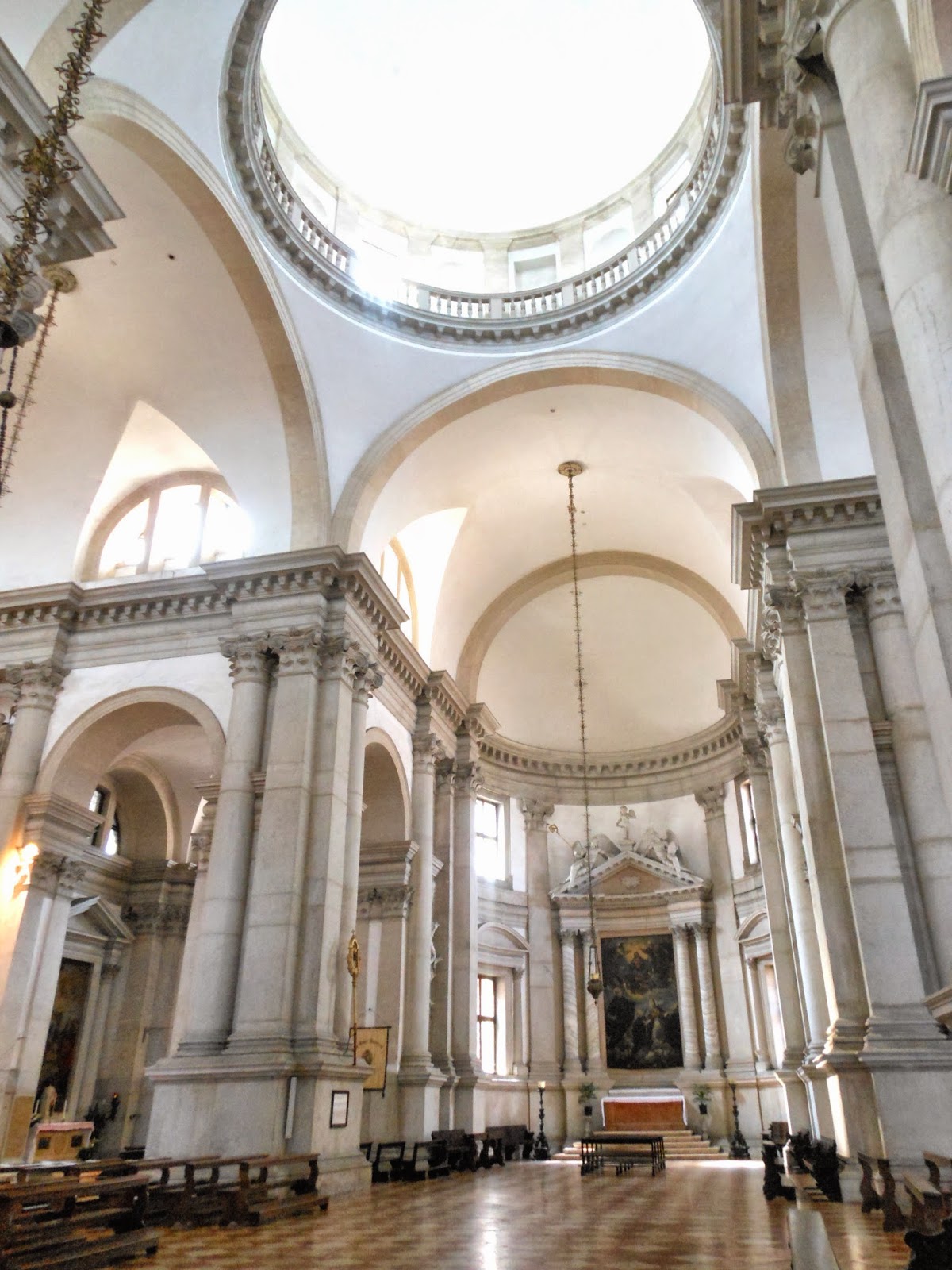
Since we now had WiFi, we spent a little time there checking e-mails before heading back out for our final sightseeing. We took a vaporetto to the farthest point on our side of the Grand Canal, where the peninsula ended directly across from San Marco. It was the Santa Maria della Salute Basilica (St Mary of Health).
As I stated in yesterday's post, Venice experienced an unusually devastating outbreak of the plague in 1630. As an offering for the city's deliverance from the epidemic, the Republic of Venice vowed to build and dedicate a church to Our Lady of Health. The Salute is a vast, octagonal building with two domes and a pair of picturesque bell-towers at the back. It is built on a platform made of 1,000,000 wooden piles.
If you walk from the Salute just a few yards farther east (to the left looking at the photo above this one), you reach the tip of the peninsula. The point there is called Punta Della Dogana, and I got this photo of it when we were across the lagoon earlier in the day. To the right of the point is the Grand Canal, while to the left is the Canale Della Guidecca where our cruise ship went. The grand white building on the point was originally a customs office, but is now an art museum. At the top are two slaves holding a golden ball with Atlas on top of it, made in the 1600s.
We used another vaporetto trip to cross the Grand Canal again, and walked some more in the San Marco area. This photo is the Teatro La Fenice (Theater of the Phoenix), one of the most famous and renowned opera houses in Europe. It was originally built in 1774 and was the San Benedetto Theatre. It burned down and was rebuilt, and again in 1836. Then in 1996, an arson fire completely destroyed it and it was completely rebuilt and opened in 2004. This time, to reflect its four comebacks from the ashes, they renamed it Phoenix.
Even though we didn't get to see this interior, I stole this photo from the Internet to show how glorious the new opera house is. It's funny how difficult is was to even find the front of this theater, since the streets and canals are so convoluted. How did all the people in this photo even find their way there? haha
We then went off in search of a building we saw mentioned in our Venice book, and we took this photo along the way. Our own gondola ride was coming up soon, and it turned out we went right where the gondola in this photo was going.
It took some crafty map reading and luck, but we found what we were seeking - the famous staircase of Contarini dal Bovolo. It is part of a palace home built in the 15th century, and this staircase was built in 1499. It was used extensively in Orson Welles' 1952 screen adaptation of Shakespeare's Othello.
Then it was time for our 6 pm gondola appointment! We were a bit early and watched as several tour groups came and went, but finally it was our turn.
Just the two of us and the gondolier ventured out across the Grand Canal, then we turned back and entered a small canal between two large buildings.
Here we are entering the small canal with our gondolier silhouetted against the blue sky. They operate those rudderless, shallow-draft boats using their single oar and their legs and arms to push off of buildings. Our guy spoke only a little English, and was trying to give us information, but we already knew almost everything we could understand since we'd been touring the city already.
Here we are going under some of the bridges. It was nice and quiet and serene on the course we took. We recognized some of the places since we had walked all through there. We went right behind Teatro La Felice where their shipping dock was located. Our ride was all nice and romantic!
After 30 minutes, we were back on the Grand Canal and returned to our starting point. By then it was later enough that we wanted to return to the plaza next to our BnB and find a cozy restaurant for dinner. Once we got there we ventured down a small lane off the plaza and compared several restaurant menus before selecting one.
We were the only patrons in the restaurant, as it turned out. I liked that they had on tap a German beer I was familiar with - Krombacher. My cycling T-shirt now seems out of place when I see this photo, since it was a fairly formal atmosphere with a haughty waiter. But it was yummy and we enjoyed our meal.
We returned to the BnB room to check e-mails and shower and pack, as our incredible 18-day vacation was winding down.
Janet just HAD to take this final photo. It actually was pretty hot in the room, so we relied on a fan that blew on high speed the entire night. We set the alarm for 6:30 am since our vaporetto to the airport was departing at 8:15 the next morning. What a fabulous time we had in Venice!
We walked, vaporettoed, and gondola-ed all over beautiful Venice today. This photo is at the Accademia Bridge, which took us back over to the San Marco side of the city, where we toured the majestic basilica.
It was our last morning on the Norwegian Spirit. We enjoyed our final breakfast
and thought back on what a wondrous cruise we had. The disembarking process
was smooth, and we pulled our luggage and things back over the walk and
people-mover route to get to the vaporetto at Piazzale Roma.
On our Grand Canal trip to our BnB stop, we passed by this cool "palace" with the formal painting of Jesus.
When we got to the BnB and rang the doorbell, one of the tenants answered and we put our luggage inside the entryway behind the door. It turned out that had those tenants not been there, and they left a few minutes later, we would have been out of luck. The landlord was nowhere to be seen.
Janet and I took the vaporetto on past San Marco Square and toured a church facing the lagoon, Santa Maria della Pieta (1760). It was covered in scaffolding and actually cost 3 Euro each to go inside, but we did anyway. It turned out to be the least fancy of any church we had seen on this vacation, but we enjoyed listening to the music they were playing, and getting to sit down out of the sun. There was a plaque on the exterior that threatened a curse and excommunication to all those who abandon children for whom they can provide.
We then hopped on a vaporetto and crossed to the far side of
the lagoon to this church, which you can see in the background of many of our
photos. It is San Giorgio Maggiore, built between 1566 and 1610 by Andrea
Palladio, considered the most influential individual in the history of Western architecture. Those yellow columns were a temporary exhibit. The interior was
lavish and magnificent, which we had grown accustomed to.
Being a Sunday, there was a service going on while we were
in there. But there were so few attendees, especially for such a massive
church, it seemed kind of odd. They were all seated close up to the pulpit, so
they are to the left of the chairs on the left side of the photo.
Outside again I got a telephoto close-up of
Saint George on top of the cupola.
Here is another shot of the church faҫade, which is known
for how white it is. You can see the statue from the previous photo on top of
the cupola to the right of center.
Here's a "famous" view of the San
Marco Square area taken from across the lagoon
where we were at St George's Church.
We were waiting for a vaporetto to come take us to our next destination along
the waterway where our ship originally passed through.
The next stop was this church of Santa Maria del Rosario
(1743) (I took the photo a day earlier when our ship cruised passed). They had to drive
270 piles into the soil to support the weight of the church's faҫade. As usual, it was beautiful inside.
We then walked to the Accademia Bridge, after needing to pay 1.5€ to use a public restroom in this busy area. I took this photo of all the locks on the bridge, and they were crammed onto every post of the entire crossing. It's amazing how popular this fad has become in Europe after we first learned about it a year ago in Innsbruck.
Immediately on the far side of the bridge in the courtyard of Palazzo Franchetti was this cool bit of "bicycle art" that we had already seen twice before when we cruised past on the vaporetto. It is called Forever Bicycles and is made from nearly 1200 stainless steel bicycles arranged into hypnotic form. It was moved here recently from its original location in Toronto.
After this we walked back to San Marco Square to tour the basilica, which didn't allow tours until the afternoon due to its being a Sunday. No charge to enter, as none of the churches were other than our first church of the day which also was the smallest and least fancy. Inside it was pretty darned incredible. Everything seemed golden, since it was the background color of the walls and art inside; in fact, its nickname is Church of Gold. The first church here was in 828, when relics believed to be the body of St. Mark were stolen from Alexandria by two Venetian merchants and brought here to Venice. Thus, Apostle St. Mark is buried here. The current church was built as early as 1073! A highlight inside was the Golden Iconostasis, a masterpiece "curtain" separating the choir and apse which has 14 statues across it of the Crucifixion, the Apostles and Madonna.
Following this tour, it was time for us to return to the BnB to officially check in. I had told the landlord 2:30, which is what his webpage had said was the proper time. When we got there on time, there was no one to be seen. I finally went off to see if I could phone him from a pay phone, since his e-mail had said there were such phones in the nearby plaza. There were, but you needed a phone card and no one sold them. A person directed me to a tobacco shop in a different plaza a few hundreds yards away, but he didn't sell them either. So, I returned to the BnB where Janet was still waiting, and she had spoken to the owner of the shop across the lane who said she would call him for us. She did and he soon came as a result. Apparently to use this BnB, you need to have a cell phone to call him or else you're just out of luck.
He said nothing in the way of a greeting, but just led us upstairs to show us what he needed to, and then he left and we never saw him again. We actually had a great little corner room that had windows looking out in two different directions:.
This was our view eastward, and way off in the distance you can see San Marco's Campanile.
This is the view out the other window, to a plaza. The church of Campo San Barnaba is on the left. I had my one and only gelato at a little shop in this plaza (other than the gelato I had in Barcelona). Later that evening we ate at a small restaurant up the lane off the far end of the plaza.
This photo shows the canal just below our window, and the front of Campo San Barnaba. A church was first built there in the ninth century, destroyed by fire in 1105, rebuilt in 1350, and reconstructed in its present form in 1776. The church is presently de-consecrated and used for exhibits. Its faҫade was used as the old Venice library in Indiana Jones and the Temple of Doom.
We then walked to the Accademia Bridge, after needing to pay 1.5€ to use a public restroom in this busy area. I took this photo of all the locks on the bridge, and they were crammed onto every post of the entire crossing. It's amazing how popular this fad has become in Europe after we first learned about it a year ago in Innsbruck.
Immediately on the far side of the bridge in the courtyard of Palazzo Franchetti was this cool bit of "bicycle art" that we had already seen twice before when we cruised past on the vaporetto. It is called Forever Bicycles and is made from nearly 1200 stainless steel bicycles arranged into hypnotic form. It was moved here recently from its original location in Toronto.
After this we walked back to San Marco Square to tour the basilica, which didn't allow tours until the afternoon due to its being a Sunday. No charge to enter, as none of the churches were other than our first church of the day which also was the smallest and least fancy. Inside it was pretty darned incredible. Everything seemed golden, since it was the background color of the walls and art inside; in fact, its nickname is Church of Gold. The first church here was in 828, when relics believed to be the body of St. Mark were stolen from Alexandria by two Venetian merchants and brought here to Venice. Thus, Apostle St. Mark is buried here. The current church was built as early as 1073! A highlight inside was the Golden Iconostasis, a masterpiece "curtain" separating the choir and apse which has 14 statues across it of the Crucifixion, the Apostles and Madonna.
Following this tour, it was time for us to return to the BnB to officially check in. I had told the landlord 2:30, which is what his webpage had said was the proper time. When we got there on time, there was no one to be seen. I finally went off to see if I could phone him from a pay phone, since his e-mail had said there were such phones in the nearby plaza. There were, but you needed a phone card and no one sold them. A person directed me to a tobacco shop in a different plaza a few hundreds yards away, but he didn't sell them either. So, I returned to the BnB where Janet was still waiting, and she had spoken to the owner of the shop across the lane who said she would call him for us. She did and he soon came as a result. Apparently to use this BnB, you need to have a cell phone to call him or else you're just out of luck.
He said nothing in the way of a greeting, but just led us upstairs to show us what he needed to, and then he left and we never saw him again. We actually had a great little corner room that had windows looking out in two different directions:.
This is the view out the other window, to a plaza. The church of Campo San Barnaba is on the left. I had my one and only gelato at a little shop in this plaza (other than the gelato I had in Barcelona). Later that evening we ate at a small restaurant up the lane off the far end of the plaza.
This photo shows the canal just below our window, and the front of Campo San Barnaba. A church was first built there in the ninth century, destroyed by fire in 1105, rebuilt in 1350, and reconstructed in its present form in 1776. The church is presently de-consecrated and used for exhibits. Its faҫade was used as the old Venice library in Indiana Jones and the Temple of Doom.
There's Janet waving from our window! We got to watch an occasional gondolier
or
delivery boat using the canal. The room did not have air conditioning,
but at least it
had a strong fan that saved us that afternoon and all night long.
Since we now had WiFi, we spent a little time there checking e-mails before heading back out for our final sightseeing. We took a vaporetto to the farthest point on our side of the Grand Canal, where the peninsula ended directly across from San Marco. It was the Santa Maria della Salute Basilica (St Mary of Health).
As I stated in yesterday's post, Venice experienced an unusually devastating outbreak of the plague in 1630. As an offering for the city's deliverance from the epidemic, the Republic of Venice vowed to build and dedicate a church to Our Lady of Health. The Salute is a vast, octagonal building with two domes and a pair of picturesque bell-towers at the back. It is built on a platform made of 1,000,000 wooden piles.
If you walk from the Salute just a few yards farther east (to the left looking at the photo above this one), you reach the tip of the peninsula. The point there is called Punta Della Dogana, and I got this photo of it when we were across the lagoon earlier in the day. To the right of the point is the Grand Canal, while to the left is the Canale Della Guidecca where our cruise ship went. The grand white building on the point was originally a customs office, but is now an art museum. At the top are two slaves holding a golden ball with Atlas on top of it, made in the 1600s.
We used another vaporetto trip to cross the Grand Canal again, and walked some more in the San Marco area. This photo is the Teatro La Fenice (Theater of the Phoenix), one of the most famous and renowned opera houses in Europe. It was originally built in 1774 and was the San Benedetto Theatre. It burned down and was rebuilt, and again in 1836. Then in 1996, an arson fire completely destroyed it and it was completely rebuilt and opened in 2004. This time, to reflect its four comebacks from the ashes, they renamed it Phoenix.
Even though we didn't get to see this interior, I stole this photo from the Internet to show how glorious the new opera house is. It's funny how difficult is was to even find the front of this theater, since the streets and canals are so convoluted. How did all the people in this photo even find their way there? haha
We then went off in search of a building we saw mentioned in our Venice book, and we took this photo along the way. Our own gondola ride was coming up soon, and it turned out we went right where the gondola in this photo was going.
It took some crafty map reading and luck, but we found what we were seeking - the famous staircase of Contarini dal Bovolo. It is part of a palace home built in the 15th century, and this staircase was built in 1499. It was used extensively in Orson Welles' 1952 screen adaptation of Shakespeare's Othello.
Then it was time for our 6 pm gondola appointment! We were a bit early and watched as several tour groups came and went, but finally it was our turn.
Just the two of us and the gondolier ventured out across the Grand Canal, then we turned back and entered a small canal between two large buildings.
Here we are entering the small canal with our gondolier silhouetted against the blue sky. They operate those rudderless, shallow-draft boats using their single oar and their legs and arms to push off of buildings. Our guy spoke only a little English, and was trying to give us information, but we already knew almost everything we could understand since we'd been touring the city already.
Here we are going under some of the bridges. It was nice and quiet and serene on the course we took. We recognized some of the places since we had walked all through there. We went right behind Teatro La Felice where their shipping dock was located. Our ride was all nice and romantic!
After 30 minutes, we were back on the Grand Canal and returned to our starting point. By then it was later enough that we wanted to return to the plaza next to our BnB and find a cozy restaurant for dinner. Once we got there we ventured down a small lane off the plaza and compared several restaurant menus before selecting one.
We were the only patrons in the restaurant, as it turned out. I liked that they had on tap a German beer I was familiar with - Krombacher. My cycling T-shirt now seems out of place when I see this photo, since it was a fairly formal atmosphere with a haughty waiter. But it was yummy and we enjoyed our meal.
We returned to the BnB room to check e-mails and shower and pack, as our incredible 18-day vacation was winding down.
Janet just HAD to take this final photo. It actually was pretty hot in the room, so we relied on a fan that blew on high speed the entire night. We set the alarm for 6:30 am since our vaporetto to the airport was departing at 8:15 the next morning. What a fabulous time we had in Venice!
9/09/2014
Venice Charm
Day 16 Venice, Italy Saturday, August 9, 2014
We arrived at The City of Bridges at about 1 pm, cruising in with pomp and circumstance (by just being on a cruise ship) and getting to see the glory of this town on a perfect day. Ahead of us on the far left you can see the Campanile of the famous St. Mark's Basilica at San Marco Square. We disembarked at about 2:30 and enjoyed many sights until returning to the ship at 6 pm for our final night on board the Spirit.
The first land we passed by as we came in from the Adriatic Sea was this outer barrier island with tons of Saturday beachgoers. We were still several miles from Venice at this point.
East of Venice as we were still approaching, I spotted this "leaning tower". I did some Internet research to find out what it was, and it turns out there are five leaning campanili around Venice (and here I thought the one in Pisa was the only one!). So, I had to carefully compare my photo with the others to determine which it was. It is the San Pietro di Castello campanile and was the first Renaissance bell tower in
Venice, built in 1463-64. It's actually the third one built for this ancient
church, the first built in 774. The tower is completely clad in slabs of Istrian stone, and
it’s the weight of those slabs that causes it to lean.A view of our approach, although you still cannot see the famous buildings of Venice. It was a beautiful cruise as we passed canals and churches and Venetian architecture. I will be including many many photos as we passed through Venice because the approach from the cruise ship was actually a highlight of being in this famous town.
Eventually we were passing between the Venice Island on our starboard side and the Lido Island on our port side. So, I hustled to the port side of the ship and took this photo of the Lido. It had canals too!
Soon we were cruising past San Marco Square. The building in the front is the Doge's Palace, which Janet and I toured later in the day. Look at all the tourists at this very touristy spot.
And then just ahead was the mouth of the Grand Canal, where later in the day we would be coming down in a water bus (vaparetto). The church on the left is Santa Maria della Salute. In 1630, Venice experienced an unusually devastating outbreak of the plague. As an offering for the city's deliverance from the disease, the Republic of Venice vowed to build and dedicate a church to Our Lady of Health. Janet and I would tour it the next day.
As I turned my camera back toward the Doge's Palace again, I saw all these tourists on the bridge taking a photo of the Bridge of Sighs (with two gondolas headed under the first bridge). We had yet another link to Lord Byron because he was the one who gave it its name, coming from the suggestion that prisoners would sigh at their final view of beautiful Venice as they were taken from the court room in the Doge's Palace on the left to their cells in the prison on the right. Later that day when Janet and I toured the Palace, we looked out those windows at the tourists taking our photo from the bridge in front.
A Saturday afternoon in San Marco Square was beyond jammed crowded, and with all the gondolas lined up for takers. Actually, the area where all these people are is called Piazza Ducale (duke), another name for "Doge". Later in the day at about 4:30 we were there, but luckily the crowds had thinned out.
Our ship continued down the main waterway called Canale della Guidecca. That campanile you can see on the right is another one of the five "leaning towers" in Venice, the Santo Stefano.
Here is a close-up of the San Stefano leaning campanile. At some point Janet and I walked past it as we were wandering the streets of downtown Venice.
One of many water taxis plying the "roads" of Venice. This particular one passing our ship was especially cool with all its polished wood.
Continuing toward our dock. Lots of small boats passed us during our cruise in, and many of the people on them waved to us. It's hard to believe how huge we were in their busy waterway. I learned after the cruise that they have just passed a new law prohibiting cruise ships from entering Venice on the course we followed. Instead, cruise ships must go to the south completely around all the islands and enter the port from the southwest. This will be good for all the water traffic, but I'm glad we got to enter this scenic route before the new ban takes effect because it was a major highlight of the entire cruise.
Looking ahead we could see other huge cruise ships docked at the port. Soon it was time to return to our cabin to prepare to go visit this charming city.
While waiting to disembark, between our ship and another Norwegian ship we saw all this black smoke appear and we wondered what caught on fire. It kept pouring upward for about 15 minutes, and it looked like something pretty serious. We heard the sirens coming, and finally it stopped. We never heard a word about what it was.
When we did disembark, with computer in tow, we walked about 700 yards to a "people mover". On the way we bought our tickets at a small shop, but when we tried to use the tickets we thought we'd been taken because they wouldn't open the turnstiles. But we finally figured out how to do it and we caught the train for all of about 3/4 mile to the Piazzale Roma. This is where all the trains and buses and cabs and water buses (vaporetti) all converge to transport tourists and locals alike because the bridges from the mainland end there.
We bought a 24-hour ticket for the vaporetto and found our way to the #1 line toward San Marco Square. It was completely packed, and very hot and humid. Interestingly, in our 24 hours we took 11 trips on vaporetti, which pleased us that we got our money's worth.
It was SO exciting to be in Venice on the Grand Canal. The architecture was amazing and fun to see. There's about 25 miles of waterways in this town, so think of all the bridges that cross them (378 of them).
Here we are about to go under the famous Rialto Bridge, with all its shops. Engineering of the bridge was considered so audacious that architects predicted future ruin. The bridge has defied its critics to become one of the architectural icons of Venice. Janet and I visited it on foot later in the day.
Although we saw dozens of gondolas up close (Venice has about 400 total), this was our first as we passed it on the Grand Canal. And look at those beautiful buildings behind.
We elected to get off at the stop where our BnB was so that we'd know how to find it the next morning with our luggage. The stop was about 2/3 of the way along the Grand Canal, and called Rezzonico after the palace there by the same name. We hunted down the BnB based on the directions from the webpage but eventually didn't know where to go next. We stepped over into the shade of a door overhang to read the directions one more time. It turned out the door we were in front of was our BnB door!
Nearby was an Internet Cafe that doubled as a custom T-shirt shop, and we were the only ones there as we spent 45 minutes catching up on e-mails. One I had to send was to the BnB owner to confirm our arrival time the next morning to drop off our luggage (since check-in was not until the afternoon, and he did not live there). Six months earlier when I made the reservation, he had said we could indeed drop our luggage early.
Back at the vaporetto stop, we got this picture of me with the Accademia Bridge in the background. It is one of only four bridges that cross the Grand Canal.
Soon the vaporetto picked us up and we continued to San Marco Square. Here we are about to go under the Accademia Bridge.
Virtually everyone exited the vaporetto when it arrived at the San Marco stop. We walked down a narrow lane and emerged onto the square. Late in the afternoon the crowds had mostly dissipated. On the right is the library, and along the left is the Procuratie, or government offices. At the end are the Basilica and Campanile. It was too bad the basilica had so much scaffolding because the building, from 1117, is so richly decorated.
On the square's far left side (as you face the basilica) is this old clock tower from the late 1400s. At the top are two statues who strike the bell at each hour.
Even with so much of the church in scaffolding, at least we got to see some of the elaborate faҫade with its paintings and the famous four horses above the main portal. No one knows the origin of these horses, whether Greek or Roman, 4th Century BC or 2nd Century AD, or even the composition of the metal alloy. They did arrive in Venice when they were stolen from Constantinople in 1204. Napoleon stole them to Paris in the early 19th century, but they made their way back when he lost power.
We took a self-guided tour of the Doge's Palace, where the Venetian rulers lived and where the republic government convened. We're in the courtyard, but the dome in the background is from the basilica.
This is a mail drop (his mouth). Citizens were allowed to submit letters of complaint about someone, and they had to mail it in this drop.
Any
Venetian citizen could accuse someone of misdeeds by writing the
denunciation down and slipping it through specially placed Bocca di
Leone ("Lion's Mouth") slots in the Palazzo Ducale's walls. - See more
at:
http://www.reidsguides.com/italy/destinations/veneto/venice/sights/palazzo_ducale.html#sthash.vAIZhYyV.dpuf
Any
Venetian citizen could accuse someone of misdeeds by writing the
denunciation down and slipping it through specially placed Bocca di
Leone ("Lion's Mouth") slots in the Palazzo Ducale's walls. - See more
at:
http://www.reidsguides.com/italy/destinations/veneto/venice/sights/palazzo_ducale.html#sthash.vAIZhYyV.dpuf
Any
Venetian citizen could accuse someone of misdeeds by writing the
denunciation down and slipping it through specially placed Bocca di
Leone ("Lion's Mouth") slots in the Palazzo Ducale's walls. - See more
at:
http://www.reidsguides.com/italy/destinations/veneto/venice/sights/palazzo_ducale.html#sthash.vAIZhYyV.dpuf
The Golden Staircase. There was so much grandeur to see in the palace, but after this shot, the signs said no photos were allowed (which sure did not stop most people). One of the most famous pieces in the palace is the Paradise, an enormous 14th century fresco depicting the Coronation of the Virgin surrounded by the celestial hierarchies. The original was destroyed in a 1577 fire, and the replacement was done by the most famous painter at that time, JacopoTintoretto. However, he was very old and apart from its sheer scale, the painting has been considered "entirely forgettable". I did read that it WAS hailed as a masterpiece by the 500 powerful Venetians he painted into the heavens, most of whom were
Tintoretto’s patrons. This photo is from the Bridge of Sighs.I thought it was interesting how many gondolas there were. I'm just glad that when we took our gondola ride, we were the only ones around and it was nice and quiet.
The other direction from the Bridge of Sighs. So many people were taking our photo.
As we were departing, we got this photo of the Giant's Staircase in the courtyard. Those statues on either side at the top are Neptune and Mars. Over the arch is the famous symbol seen everywhere in this city: The Lion of Venice. The winged lion originally was an ancient bronze sculpture in St Mark's Square and came to symbolize the city — as well as one of its patron saints, St Mark.
Also in the palace courtyard is the original statue of St Theodore that had been atop one of the two giant granite columns in the piazzetta outside by the lagoon (the one there now is a replica). He was the city patron before St Mark, and he has the spear he used to slay the dragon. On top of the other granite column is the winged lion, which, again, is the symbol of St Mark.
When we left the palace and were back on the lagoon, we saw what we must have looked like when our ship entered the city. This ship is departing, but it sure is imposing and I can see why the city will soon no longer allow the ships to ply these waters other than from the south, farther away.
For the next hour we meandered the maze of streets and canals and bridges, and got lost! I thought we were walking one direction (westward) and it turned out we had walked north toward the Rialto Bridge. This photo of Janet is at a "typical" canal, and notice the locks on the bridge. This continues the fad we saw so many times the previous summer in Europe.
We walked over the Rialto Bridge with all its shops -- and tourists. Then we caught a vaporetto back to Piazzale Roma, got on the people mover, and walked back for our final night on the ship. We had lots of packing, and felt anxiety when our dinner service was slow when we wanted to be packing and getting ready for ship departure the next morning.
Subscribe to:
Posts (Atom)
